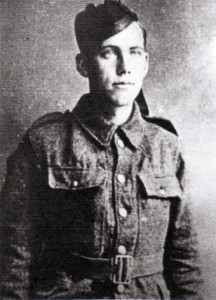| Nationality: |
United Kingdom |
| Rank: |
Private |
| Regiment/Service: |
Highland Light Infantry |
| Unit Text: |
12th (Service) Battn. |
| Age: |
21 |
| D:O:B: |
|
| Born: |
1893, Aughrim, Castledawson. |
| Enlisted: |
Glasgow |
| Residence: |
Aughrim |
| Date of Death: |
25/09/1915 |
| Service No: |
19892 |
| Casualty Type: |
Commonwealth War Dead. KIA. |
| Grave/Memorial Ref: |
Panel 108 to 112. |
| Memorial: |
Loos Memorial, Pas De Calais, France. |
| Additional information: |
In 1911 Marshall was a cloth starcher. A son of William John and Sarah Watterson, Cliftonville Cottage, Aughrim, Castledawson, Co. Londonderry. Brother of George. |
|
Born on the 30th August 1893 at Aughrim, Castledawson, the seventh son of William John and Sarah, he grew up during the rise of the Home Rule Movement and witnessed the arming of the Ulster Volunteers. In September 1914, one month after war broke out, he answered the call to arms and travelled to Glasgow where he enlisted in the Highland Light Infantry, the same regiment that his younger brother George had joined a few months earlier. He was assigned to the 12th Battalion and later volunteered for sniper duty. Unfortunately, Marshall's service records were amongst those destroyed by enemy action in 1940. The only official records are those of the Commonwealth War Graves Commission which state: |
|
Marshall Watterson, Pte. 19892, serving with the 12th Battalion, Highland Light Infantry, died on the 25th September 1915, aged 21 and, sadly, has no known grave. He is therefore commemorated by name, along with others from his regiment, on Panels 108 to 112 of the Loos Memorial, France. |
|
Loos-en-Gohelle is a village about 5 kms. North West of Lens. The Loos Memorial, which forms part of the Dud Corner Cemetery, is about one and a half kilometres west of the village on the main road from Bethune to Lens. |
|
Although his service records no longer exist, we have been able, from other sources, to discover what action Marshall was involved in when he made the ultimate sacrifice for king and country. He was in ‘A’ Company / 12th Battalion, attached to the 46th Brigade / 15th Scottish Division, and went into action for the last time at 0630 hrs on Sat 25th September 1915. His battalion was in the first wave of attack on that fateful day, and the action is vividly described in chapter XV of the book 'Proud Heritage' as follows: |
|
"The Allied offensive at Loos was planned for the 25 / 09 / 1915 and new army divisions poured into France, bringing the total of imperial troops to 28 Divisions, numbering 916,605 men. Among them was the 15th Scottish Division, a very fine one, raised at Aldershot in 1914 and included the 12th Highland Light Infantry in its 46th Infantry Brigade. In the hope of making up to some extent for the scarcity of Howitzer ammunition, the plans for the Battle of Loos included the use of Chlorine gas (so effectively employed by the Germans at Ypres). It was brought into the front-line trenches in cylinders which 40 Gas Officers had been specially trained to let off at the appropriate moment. Dawn on the 25th found the front-line troops lying about on the fire-steps and in the mud of the trench bottoms, trying to snatch a little sleep before going into action. They required no orders to stand-to, for the terrific roar of the artillery bombardment which opened at 0550 hrs brought them to their feet. The gas hissed out of the cylinders, and its yellowish fumes mixed with the smoke-screen to form a dense cloud all along the battle-front. At 0615 hrs they lined the parapets waiting while the minutes ticked their way to Zero Hour. At 0630 hrs they went over the top and, with their rifles at high-port, advanced across the open in extended lines with 50 paces interval between each line. The 15th Scottish Division attacked with 2 Brigades directly up towards Loos, in the 46th Brigade, the 12th H. L. I. sent 2 Companies with the first wave who were to remain in the captured German trenches until the rest of the Battalion passed through them. Although many men were suffering from the effects of our own gas, the advance went well and passed over the German trenches with no pause to collect prisoners. |
|
The 44th Brigade, on the right, reached and advanced through Loos while the 46th Brigade took Hill 70, and the H. L. I. captured 6 German guns. (Later displayed on the Horse Guards parade). |
|
The flank of the 44th Brigade was, however, exposed and as the German third line came into enfilade on the left, an attempt was made to halt the advance. But by this time so many officers and NCO's had fallen that there was no way of stopping it. The leaderless troops pushed on down the far side of the Hill 70 towards Lens, finally disintegrating in front of the machine-gun fire which poured upon them from three sides. |

